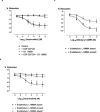Activation of nitric oxide synthase by beta 2-adrenoceptors in human umbilical vein endothelium in vitro
- PMID: 10372832
- PMCID: PMC1565965
- DOI: 10.1038/sj.bjp.0702512
Activation of nitric oxide synthase by beta 2-adrenoceptors in human umbilical vein endothelium in vitro
Abstract
1. Some animal studies suggest that beta-adrenoceptor-mediated vasorelaxation is in part mediated through nitric oxide (NO) release. Furthermore, in humans, we have recently shown that forearm blood flow is increased by infusion of beta2-adrenergic agonists into the brachial artery, and the nitric oxide synthase (NOS) inhibitor N(G)-monomethyl-L-arginine (L-NMMA) inhibits this response. 2. The purpose of the present study was to determine whether stimulation of human umbilical vein endothelial beta-adrenoceptors causes vasorelaxation and nitric oxide generation, and whether this might be mediated by cyclic adenosine-3',5'-monophosphate (cyclic AMP). 3. Vasorelaxant responses were determined in umbilical vein rings to the nonselective beta-adrenergic agonist isoprenaline and to the cyclic AMP analogue dibutyryl cyclic AMP, following precontraction with prostaglandin F2alpha. 4. NOS activity was measured in cultured human umbilical vein endothelial cells (HUVEC) by the conversion of [3H]-L-arginine to [3H]-L-citrulline, and adenylyl cyclase activity by the conversion of [alpha-32P]-ATP to [32P]-cyclic AMP. 5. Isoprenaline relaxed umbilical vein rings, and this vasorelaxation was abolished by beta2- (but not beta1-) adrenergic blockage, and by endothelium removal or 1 mM L-NMMA. In addition, vasorelaxant responses to dibutyryl cyclic AMP were inhibited by 1 mM L-NMMA, with a reduction in Emax from 90.0+/-9.3% to 50.5+/-9.9% (P<0.05). 6. Isoprenaline 1 microM increased NOS activity in HUVEC (34.0+/-5.9% above basal, P<0.001). Furthermore, isoprenaline increased adenylyl cyclase activity in a concentration-dependent manner; this response was inhibited by beta2 (but not beta1-) adrenergic blockade. Forskolin 1 microM and dibutyryl cyclic AMP 1 mM each increased NOS activity in HUVEC, to a degree similar to isoprenaline 1 microM. The increase in L-arginine to L-citrulline conversion observed with each agent was abolished by coincubation with NOS inhibitors. 7. These results indicate that endothelial beta2-adrenergic stimulation and cyclic AMP elevation activate the L-arginine/NO system, and give rise to vasorelaxation, in human umbilical vein.
Figures






Similar articles
-
Mechanisms underlying beta2-adrenoceptor-mediated nitric oxide generation by human umbilical vein endothelial cells.J Physiol. 2006 Oct 15;576(Pt 2):585-94. doi: 10.1113/jphysiol.2006.115998. Epub 2006 Jul 27. J Physiol. 2006. PMID: 16873402 Free PMC article.
-
Nitric oxide-dependent vasodilatation of rabbit femoral artery by beta(2)-adrenergic stimulation or cyclic AMP elevation in vivo.Br J Pharmacol. 2000 Mar;129(5):969-74. doi: 10.1038/sj.bjp.0703155. Br J Pharmacol. 2000. PMID: 10696097 Free PMC article.
-
beta(2)-adrenoceptors activate nitric oxide synthase in human platelets.Circ Res. 2000 Jul 7;87(1):39-44. doi: 10.1161/01.res.87.1.39. Circ Res. 2000. PMID: 10884370
-
The role of nitric oxide in carotid chemoreception.Biol Signals. 1995 May-Jun;4(3):109-16. doi: 10.1159/000109430. Biol Signals. 1995. PMID: 8750936 Review.
-
Selective inhibitors of neuronal nitric oxide synthase--is no NOS really good NOS for the nervous system?Trends Pharmacol Sci. 1997 Jun;18(6):204-11. doi: 10.1016/s0165-6147(97)01064-x. Trends Pharmacol Sci. 1997. PMID: 9226999 Review.
Cited by
-
Greater Beta-Adrenergic Receptor Mediated Vasodilation in Women Using Oral Contraceptives.Front Physiol. 2016 Jun 8;7:215. doi: 10.3389/fphys.2016.00215. eCollection 2016. Front Physiol. 2016. PMID: 27375493 Free PMC article.
-
Nitric oxide loading reduces sickle red cell adhesion and vaso-occlusion in vivo.Blood Adv. 2019 Sep 10;3(17):2586-2597. doi: 10.1182/bloodadvances.2019031633. Blood Adv. 2019. PMID: 31484636 Free PMC article.
-
Nitric oxide synthase and cyclooxygenase modulate β-adrenergic cutaneous vasodilatation and sweating in young men.J Physiol. 2017 Feb 15;595(4):1173-1184. doi: 10.1113/JP273502. Epub 2016 Dec 12. J Physiol. 2017. PMID: 27779753 Free PMC article.
-
Cyclic AMP elevating agents and nitric oxide modulate angiotensin II-induced leukocyte-endothelial cell interactions in vivo.Br J Pharmacol. 2001 Jun;133(4):485-94. doi: 10.1038/sj.bjp.0704096. Br J Pharmacol. 2001. PMID: 11399665 Free PMC article.
-
Sex and ageing differences in resting arterial pressure regulation: the role of the β-adrenergic receptors.J Physiol. 2011 Nov 1;589(Pt 21):5285-97. doi: 10.1113/jphysiol.2011.212753. Epub 2011 Aug 22. J Physiol. 2011. PMID: 21859824 Free PMC article.
References
-
- BAYDOUN A.R., EMERY P.W., PEARSON J.D., MANN G.E. Substrate-dependent regulation of intracellular amino acid concentrations in cultured bovine aortic endothelial cells. Biochem. Biophys. Res. Commun. 1990;173:940–948. - PubMed
-
- BILSKI A., HALLIDAY S.E., FITZGERALD J.D., WALE J.L. The pharmacology of a β2-selective adrenoceptor antagonist (ICI 118,551) J. Cardiovasc. Pharmacol. 1983;5:430–437. - PubMed
-
- BLANKESTEIJN W.M., THIEN T. Effect of NG-monomethyl-L-arginine on the β-adrenoceptor-mediated relaxation of rat mesenteric resitance arteries. Life Sci. 1993;52:PL135–PL139. - PubMed
Publication types
MeSH terms
Substances
Grants and funding
LinkOut - more resources
Full Text Sources

